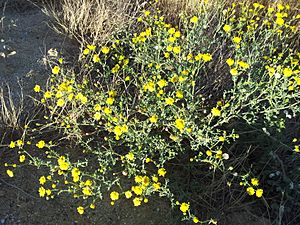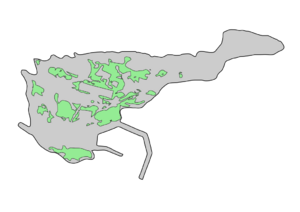Senecio gallicus facts for kids
Quick facts for kids Senecio gallicus |
|
|---|---|
 |
|
| Scientific classification | |
| Synonyms | |
|
Senecio gallicus Vill. |
Senecio gallicus, also known as the French groundsel, is a type of plant that lives for only one year. It belongs to the Senecio group and the Asteraceae family, which includes daisies and sunflowers. This plant is special because it can grow in tough places with difficult conditions.
You can find Senecio gallicus in southern France and the Iberian Peninsula. It grows in deserts, dry shrublands, and even salty coastal plains. This plant plays a big role in how plant groups are formed over time, showing how different populations are connected.
Contents
What is Senecio gallicus?
Senecio gallicus is an interesting plant for scientists. It is one of the few plants that can handle a lot of salt in the soil, which is called being a halophyte. Scientists have studied its family tree to understand how it spread and changed over time.
Studies show that this plant survived during the Ice Ages by living in safe spots along the coast.
Meet the Endangered Azuzón de Alborán
One very special type of Senecio gallicus is called Senecio alboranicus, or azuzón de Alborán. This plant is in great danger of disappearing. It only lives on a tiny island called Isla de Alborán. The IUCN says it is critically endangered.
Isla de Alborán is a small volcanic island, only about 7.1 hectares in size. That's like 10 football fields! It is located about 48 kilometers (30 miles) from the coast of Spain and 39 kilometers (24 miles) from Africa. S. alboranicus is one of 26 plant types found on this small island.
How Azuzón de Alborán Survives
Like other Senecio plants, the azuzón de Alborán is very tough. It grows in places that are often disturbed, like areas with volcanic ash and sandy soil. These areas have been changed by nature and by people over time.
This plant can grow three times a year! It also doesn't compete much with other plants. The middle group of S. alboranicus plants shares its space with other plants like Lavatera mauritanica and Anacyclus alboranensis. What makes it special is that it loves salty soil, which is unusual for its plant group.
Where Azuzón de Alborán Grows
Azuzón de Alborán can be found growing from sea level up to about 15 meters (49 feet) high. Because the island is so small and its home is so rare, this plant is very sensitive to changes. Things like how much rain falls, how salty the soil is, and even human activities can affect it.
In the past, there was a lighthouse on the island with staff, and now there is a military presence. These changes can cause the number of plants to go up and down each year. They also affect how big the plants grow and how many flowers they have. The plant's decline might be due to human activities, natural changes, or even threats from other living things like diseases.
Protecting Azuzón de Alborán
Isla de Alborán is a protected area and a marine park. It is very important for the Mediterranean region and is protected by the Barcelona Convention. The azuzón de Alborán plant is also listed in a special agreement called the Bern Convention. If you want to visit the island to see this plant, you need special permission from the Ministry of Defence.
Where Senecio gallicus Lives
Senecio gallicus can be found at different heights, from about 15 meters (49 feet) to 1400 meters (4,593 feet) above sea level.
Native Homes
* Southwestern Europe: Alborán, Formentera, Ibiza, Italy, France, Monaco, Morocco, Portugal, Spain
Naturalized and Native Homes
This means it grows naturally in these places, and has also spread to others.
* Western Asia: Israel * Southwestern Europe: Alborán, Formentera, Ibiza, Italy, France, Monaco, Morocco, Portugal, Sicily, Spain * Middle Europe: Belgium * North Europe: Sweden
See also
 In Spanish: Arnica falsa para niños
In Spanish: Arnica falsa para niños


